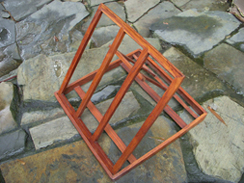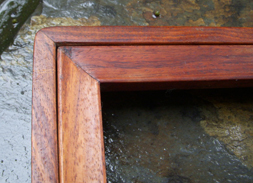The taste of water
Subtle, significant distinctions
For holding a rectangular mirror, most likely with a silvered back. The action of setting it up the stand and folding it flat again are clean and undertaken with a minimum of complexity. It comes together neatly in a well-proportioned and regular pattern that is offset only by the catchment on the back. This, in being made visible, suggests the operation. Its workings and visible logic are as straightforward as a classic piece of twentieth century modernism.
But it differs from manufactured modern works in the care to surface detail. Without any dramatic shift, the form gently swells and turns, with a concave surface along the dynamic parts exchanging for a firm (but rounded) bounding frame. Beneath, the base is articulated to create a foot that gives it a clearer impression of standing on its own. The attention given to these details is no less than that which would be given to a much larger piece of domestic furniture.
 |  |  |